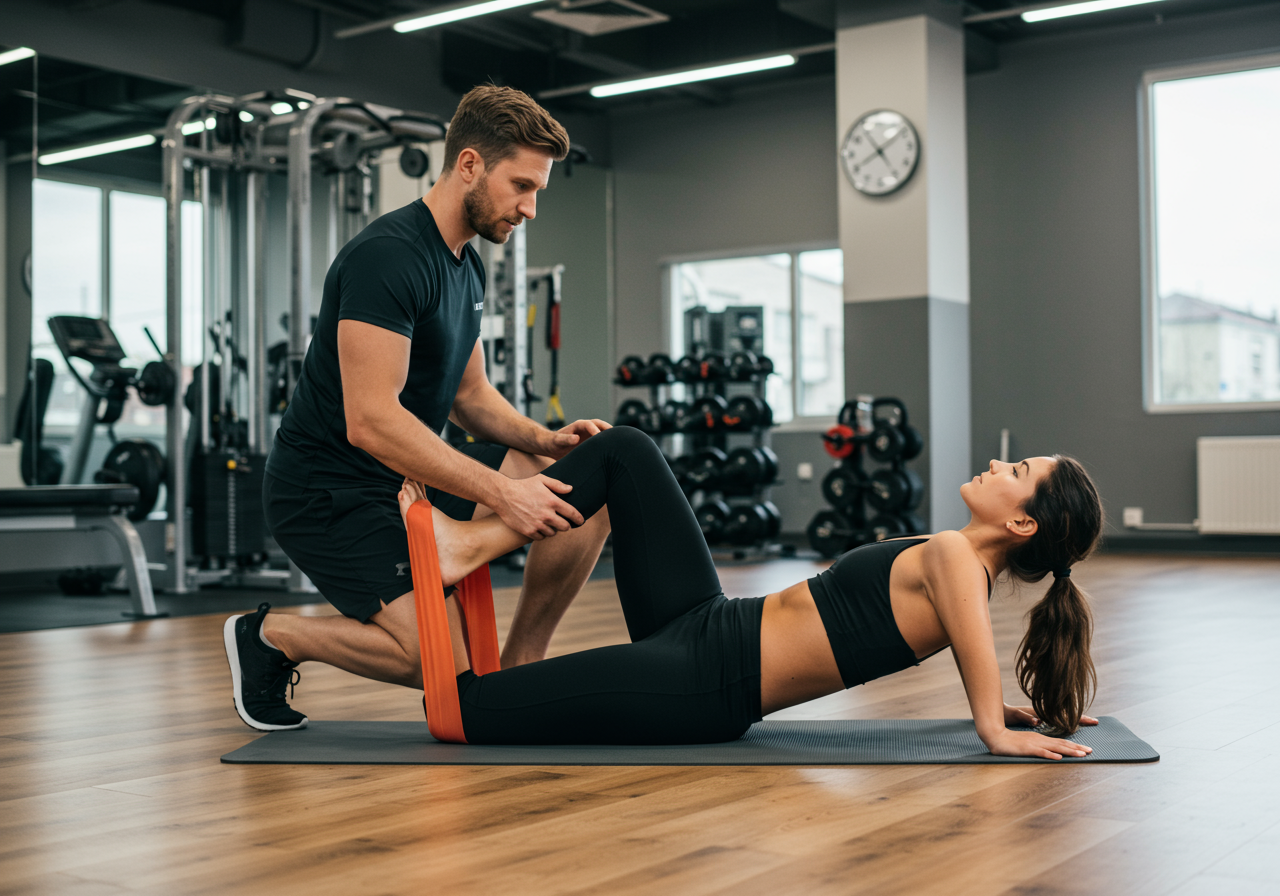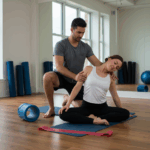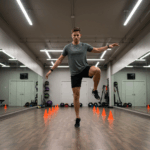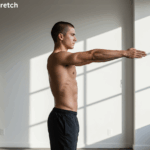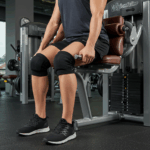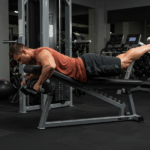PNF Stretching: Why It Works and How It Complements All Training

PNF stretching expands range while protecting joints
PNF stands for proprioceptive neuromuscular facilitation. It uses gentle contractions to help muscles relax deeper. It works by tapping the nervous system to reduce guarding.
I integrate PNF with strength and cardio for full-body progress. The method improves posture, joint angles, and lifting positions. It also reduces stiffness that slows running and cycling.
My first trial was post-deadlift PNF for hamstrings. I used 6-second contractions at 40% effort. My hip hinge felt smoother by week two. My RDL depth improved without lumbar rounding.
| Principle | What to Do | Benefit |
|---|---|---|
| Contract-then-stretch | 6–8s isometric at 30–60% effort, then exhale deeper | Safer depth via reflex relaxation |
| Low fatigue | 2–4 rounds per muscle, 2–4 days weekly | Consistency without soreness |
| Timing matters | Use after workouts or on separate sessions | Preserves power and strength |
This system connects mobility to performance. Better positions increase strength potential and reduce energy leaks in cardio. Your joints feel more open. Your movement feels efficient.
Step-by-Step PNF Methods You Can Use Today

Follow clear steps for safe and effective PNF
Start with a warm-up. Use 3–5 minutes of light cardio and easy dynamic moves. You will feel tissues more pliable and responsive.
1) Hold-Relax (Hamstrings, with strap)
– Lie supine. Loop a strap around the mid-foot. Raise the leg to a comfortable stretch.
– Inhale. Gently push the foot downward into the strap for 6–8 seconds. Keep hips square.
– Exhale. Stop contracting and pull the leg a few degrees higher for 15–20 seconds.
– Repeat 2–3 rounds per side.
2) Contract-Relax (Hip Flexor and Quads, half-kneel)
– Assume half-kneel. Tuck pelvis slightly. Hold a stable support.
– Inhale and lightly try to drag the back knee forward against the floor for 6–8 seconds.
– Exhale and glide hips forward for 15–20 seconds. Keep ribs stacked over pelvis.
– Repeat 2–3 rounds per side.
3) CRAC (Pecs/Lats at doorway)
– Set forearm on the doorframe. Step through until you feel a mild chest stretch.
– Contract the chest by pressing into the frame for 6–8 seconds.
– Immediately contract the opposing muscles. Pull shoulder blades back and down for 3–5 seconds.
– Exhale and deepen the stretch 15–20 seconds. Repeat 2–3 rounds.
| Muscle Group | Technique | Contraction | Stretch | Rounds |
|---|---|---|---|---|
| Hamstrings | Hold-Relax | 6–8s @ 30–60% | 15–20s | 2–3 |
| Hip Flexors/Quads | Contract-Relax | 6–8s @ 30–50% | 15–20s | 2–3 |
| Pecs/Lats | CRAC | 6–8s + 3–5s opposite | 15–20s | 2–3 |
Build-Your-Week Plan: Strength, Cardio, and PNF Together

Use a simple weekly architecture for steady gains
You will get better results by planning. Pair strength and cardio with short PNF blocks. Keep total time under control.
| Level | Weekly Layout | Strength Focus | Cardio Focus | PNF Focus |
|---|---|---|---|---|
| Beginner | 3 days strength, 2 days cardio | Full-body 3x/week, RPE 6–7 | Zone 2, 25–35 min | 10 min after lifts |
| Intermediate | 4 days strength, 3 days cardio | Upper/Lower split, RPE 7–8 | 2x Zone 2, 1x HIIT | 12–15 min targeted |
| Advanced | 4–5 strength, 3 cardio | Periodized, RPE 7–9 | 1 long Zone 2, 1 tempo, 1 HIIT | 15–20 min, joint-specific |
– Mon: Full-body strength 40 min → PNF hamstrings/pecs 10 min.
– Tue: Zone 2 cycle 30 min (HR 60–70% max).
– Thu: Full-body strength 40 min → PNF hip flexors/lats 10 min.
– Sat: Brisk walk or jog 35 min (HR 65–72% max).
– Sun: Optional 10 min PNF circuit.
I track heart rate with Garmin. I run Zone 2 at 135–145 bpm. I upload runs to Strava. I log food in MyFitnessPal. I set alerts on my Garmin to avoid drifting into Zone 3.
| Lift | Sets x Reps | Load Progression | PNF Pair |
|---|---|---|---|
| Goblet Squat | 3×8 | Add 2–5 lb weekly if RPE ≤7 | Hip flexor CR |
| Romanian Deadlift | 3×8 | Add 5–10 lb every 1–2 weeks | Hamstring HR |
| Push-ups | 3xAMRAP sub-2 reps | Add reps until 15, then load | Pec CRAC |
My data example: Week 1 RDL 135×8 at RPE 7. Week 6 RDL 175×8 at RPE 7. Hip hinge improved due to hamstring PNF after each session.
Progression knobs: Increase contraction to 50–60%, add one round, or change joint angle. However, maintain relaxed breathing and smooth exhalations.
Breathing, Mind-Body Control, and Recovery That Accelerates Flexibility

Use breath and recovery to make range stick
Breathing guides your nervous system. Slow exhales reduce muscle guarding. Your stretch deepens without force.
I cue gentle tongue-to-palate breathing. I keep abdominal pressure soft. My clients relax faster and stop clenching.
Recovery fundamentals support tissue change. Aim for 7.5–8.5 hours of sleep. Track HRV and resting heart rate. I use Garmin Body Battery to avoid hard sessions when drained.
| Area | Target | Notes |
|---|---|---|
| Protein | 1.6–2.2 g/kg/day | Promotes recovery and tendon health |
| Carbs | 3–5 g/kg/day | Supports cardio and reduces tightness sensation |
| Fats | 0.8–1.0 g/kg/day | Helps hormones and joint comfort |
| Hydration | 30–40 ml/kg/day | Add electrolytes in heat |
I use MyFitnessPal to keep protein near 170 g at 92 kg bodyweight. I keep calories around maintenance on mobility focus days. I increase 200–300 kcal on hard strength days.
Real Results, Troubleshooting, and Long-Term Momentum

Field-tested outcomes and what to adjust next — long-term result interpretation
Numbers confirm progress. I record angles, strength loads, and running splits. I also log perceived tightness.
| Person | Baseline → 6–8 Weeks | Notes |
|---|---|---|
| Me | Hamstring SLR 62° → 74°; Sit-and-reach +7 cm; 5K 22:18 → 21:38; VO2 max +8% | PNF 4x/week after lifts; Zone 2 plus 1 HIIT |
| Maya, 42 | Shoulder flexion 140° → 165°; Deadlift 95 lb → 155 lb | Neck tension reduced; posture improved |
| Ken, 35 | Hip extension +10°; 10K pace -18 sec/km | Stride opened from hip flexor PNF |
HIIT helped fat loss more than steady-state for me. However, Zone 2 improved recovery and kept legs fresh for PNF. I used one HIIT session weekly at HR 90–95% max.
| Issue | Likely Cause | Adjustment |
|---|---|---|
| Plateaued range | Too much tension or fatigue | Lower effort to 30–40%; add one rest day |
| Soreness next day | Contractions too hard or too many rounds | Use 2 rounds; keep 6s holds; breathe longer |
| Loss of strength | PNF before heavy lifting | Move PNF to post-lift or off-day |
| Low motivation | Long sessions | Use the 10-minute circuit; stack with coffee |
Maintain results with two PNF sessions weekly after training. Add one short mobility micro-session on rest days. Your range holds when you lift through it and breathe well.
